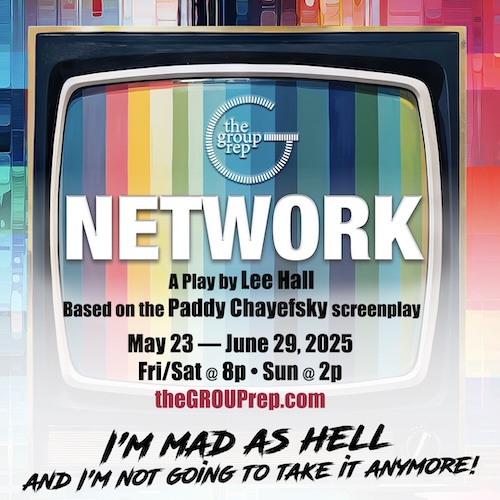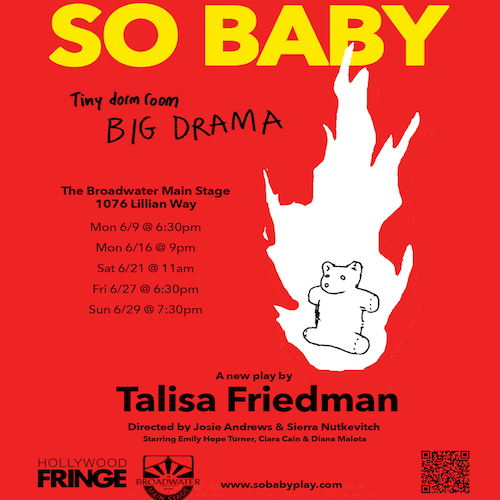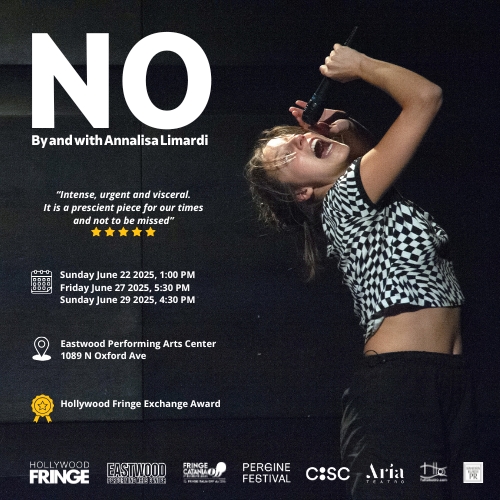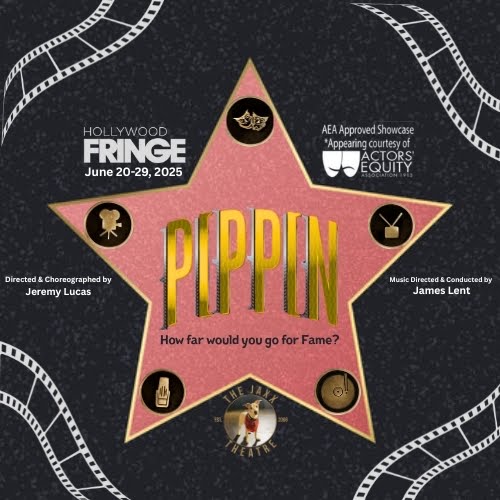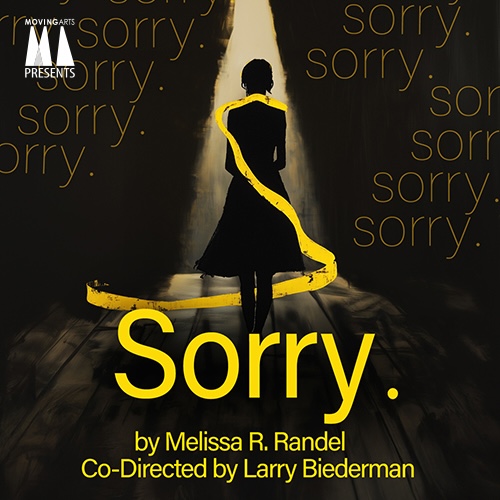From Bauhaus to Our House
The Buttoned-Down Brain of Tom Jacobson
By Steven Leigh Morris
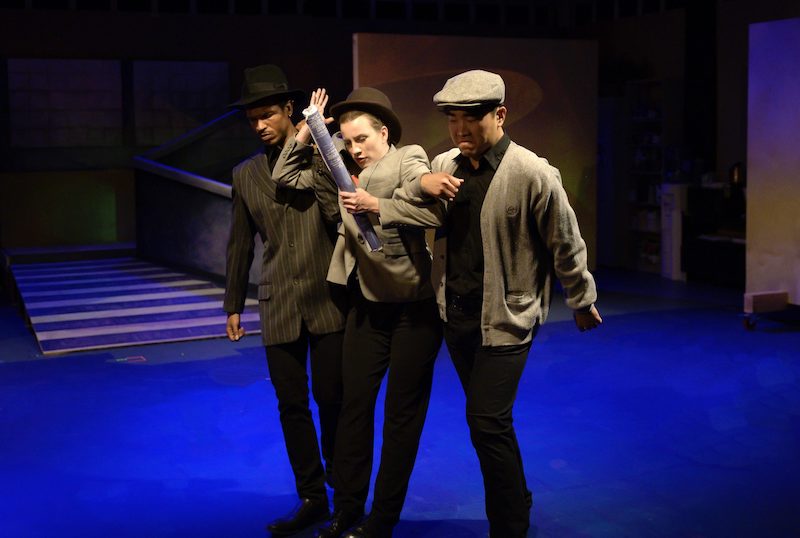
John C. Sweet, Katerina Joy Lopez, and Sang Kim
in “The Bauhaus Project” (Photo by Francisco Hermosillo III)
Playwright Tom Jacobson could be dubbed L.A.’s T.S. Eliot (the poet-playwright author of “Four Quartets” who died in 1965, in London).
Jacobson grew up in Oklahoma, Eliot in Missouri. One migrated to Los Angeles, the other emigrated to the UK (renouncing his U.S. citizenship). Both have supported their art by working for moneyed institutions. Jacobson has worked at the Los Angeles County Museum of History and as a fundraiser. At one point, Eliot worked as a clerk for Lloyd’s Bank in London to support his writing. There are distinctions, of course. Jacobson is gay and in a stable, long-term partnership with Ramon Muñoz (married for the past two years), whereas Eliot was straight, encumbered by a wife (Vivienne Haigh-Wood Eliot) who was institutionalized for mental instability (her symptoms suggested bipolar disorder and paranoid schizophrenia). Yet both Jacobson and Eliot have written probing, demanding, and contemplative works that explore the nature of writing itself, as well as how shapes and formations found in classical art and mythology reflect and shape how we see things.
Though Jacobson has 68 plays and over one hundred productions under his belt, he has yet to be embraced by America’s larger, regional theaters. Given his longevity as a playwright (his first professional production, after graduating from UCLA’s MFA playwriting program, was in 1987 (The Glory of Her Sex, produced by West Coast Ensemble), this could be seen as sign of the constricted view of American institutional theaters which have, for decades, been avoiding rather than embracing challenging work on their stages.
Not so L.A.’s smaller theaters, thank goodness, from Playwrights’ Arena, to the Boston Court Performing Arts Center, to The Skylight Theatre to Echo Theater Company, to Road Theatre Company, to Circle X Theatre Company, and others, all of which had taken a Jacobson play, or plays, under their wing. There are, at present, two companies presenting three Jacobson works, though one (a partnership of The Victory Theatre Center and Son of Semele Ensemble) staged a brief, currently-closed run of Jacobson’s play, Crevasse, centered on a meeting between the Nazi propagandist Leni Riefenstahl and American entrepreneur Walt Disney. Crevasse will return to the Victory in October. Collectively, the three plays grapple with the domestic and international ramifications of fascism.
Open Fist Theatre Company is putting on two of these thematically related Jacobson plays through this coming weekend. Collectively, these are called The Bauhaus Project. They can be seen in tandem on Saturday (4 pm and 8 pm), or individually on Friday and Sunday.
The Project, directed by Martha Demson with an ensemble made up of Katarina Jay Lopez, Jack Goldwait, Sang Kim, Chloe Madriaga, John C. Sweet and David Leonard, marks a major step in Jacobson’s prodigiously researched and erudite devotion to European history — one that’s entirely scintillating and, at times, clattering.
It clatters because so many tangentially related ideas have been dumped, as though by a bulldozer’s blade, onto the stage.
It falls upon us, the audience, to sort out the pertinence of, for instance, the respective powers and shortcomings of a collective institution versus a hierarchical institution with a single and perhaps charismatic leader; a discussion of the art and functionality of a lightweight chair; and the power imbalance between the faculty of a contemporary art school and its students, an imbalance echoed in a showdown between the representative of a national government in 1933 and an art school’s administrator in, oh, let’s just say Nazi Germany for jollies.
It turns out that the 1930s art school, The Bauhaus, is financially independent and not a recipient of government funding, but that doesn’t stop the government from dictating the terms of its right to exist. This recalls a mantra of the current U.S. nominee for Vice President Tim Walz, “Mind your own damn business,” which, through Jacobson’s lens, connects a certain sector of contemporary American politics (which delights in intruding upon what books can and can’t be read in public schools and libraries) to, oh, let’s just say the government of Nazi Germany, for jollies.
So it turns out that Jacobson’s broad array of ideas are connected, and those connections reveal the breadth of his imagination. The burden is on us to find those connections and to sort them out. This project doesn’t offer facile diversion — rather, it offers us labor, and the reward of that labor is well-worth its trouble.
All of this doesn’t even address the jaw-dropping beauty of what can only be called arias in Jacobson’s writing. For example, in part three of this project, Berlin, Bauhaus director Mies van der Rohe delivers a lecture on Charlemagne’s Chapel at Aachen, Germany. (Jacobson’s play doesn’t specify that the image be shown, but director Demson tosses it up on a stage wall projection).
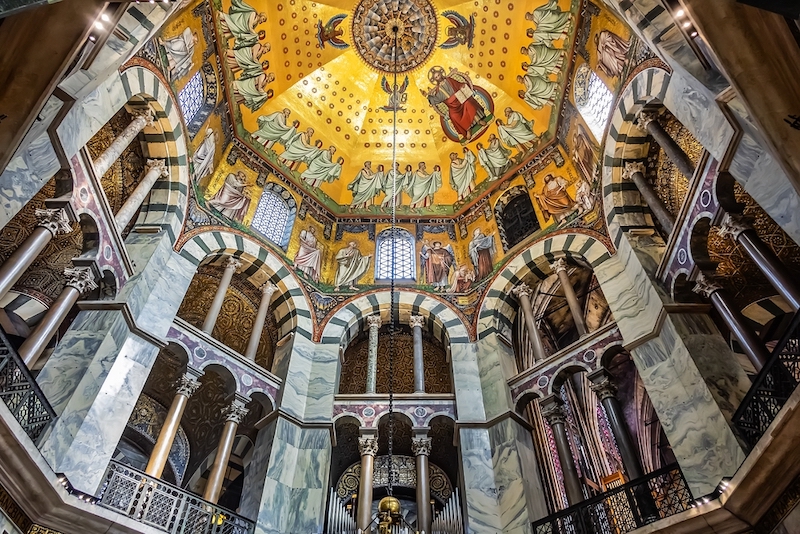
Interior of Roman Catholic Aachen Cathedral (Aachener Dom), one of the oldest cathedrals in Europe (from 796).
“Beauty. It is proportions pleasing to the eye because of the arithmetic in our bones. Charlamagne’s Chapel at Aachen is 33 meters high, an octagon embraced by a polygon of 16 sides. One measurement is doubled or halved throughout, to powerful effect. It is perfection. Modern architecture, with new engineering and new materials, has the opportunity and responsibility to meet the human need for beauty as well as function. Your work must also be perfect. If I hand you back your drawing covered in black marks, do not cringe at the corrections, simply fix it.”
Jacobson’s Project is not perfect. It, too, needs fixing. And when it is fixed, it, too, can be a work of perfection and of timeless beauty.
Let’s start with the premise: Six young students in a contemporary art school, something like Cal Arts, and presumably in Southern California though that’s not specified, are on academic probation, and are on the brink of being expelled. One hasn’t come up with tuition, while another has been deemed “uncooperative” when working on collaborative projects. The family of a third, from some unspecified foreign country, was “disappeared” and he dreads being returned, but he’s not faring well academically. And so on.
As atonement, or what these students call punishment, some dean has assigned them to perform in a play of their making, a play that traverses the history of The Bauhaus art school in Germany, from 1919-1925 (this is the play, Weimar). The second play consists of two parts, Dessau (1925-1932), and then Berlin (1932-1933). The students play multiple roles, portraying the Bauhaus characters plucked from that history: founder Walter Gropius, his sexually precocious wife Alma Mahler, Swiss expressionist painter Johannes Itten, Swiss architect Hannes Meyer, architect Ludwig Mies van der Rohe, Swiss painter Paul Klee, composer Arnold Schönberg, Russian-Jewish painter Wassily Kandinsky, textile designer Gunta Stöltzl, drapery designer Maria Kipp, teacher and textile artist Otti Berger, American cartoonist Lyonel Feininger, Jewish-Hungarian painter Lazlo Maholy-Nagy, Jewish-Hungarian architect and furniture designer Marcel Breuer, painter-choreographer Oskar Schlemmer, painter-sculptor-photographer Herbert Bayer, architect Ludwig Hilsberseimer, and Fritz Ertl, an Austrian architect and Bauhaus student who became a Nazi party member and designed buildings at Auschwitz. Sweet.
In order to save their academic skins, the contemporary students must work collaboratively to excavate this small but potent sliver of European art history that sends a searchlight out into the skies of the future. At the base of that searchlight, in the chamber that holds its bulb, resides the power source of fascism and its attendant anti-Semitism, brownshirts forever on the march across time and territory.
The Bauhaus School, as envisioned by founder Walter Gropius, was dedicated to the combination of art and utility: clean, modernist lines that literally showed up in skyscrapers across America (if you look at some of the original brick multistory apartment buildings across Sixth and Eighth streets near downtown L.A., that’s Bauhaus. As Jacobson’s play points out, its contemporary descendant in home furnishing design is Ikea, which turned a 15% profit this year over last. It’s an idea whose time has not passed.
Keep in mind, the six students are not all theater majors: One is a graphic designer; another is studying music composition, so if their portrayal of historical figures tumbles outside conventional margins, this is all very much part of the conceit — I certainly bought into it.
When John C. Sweet’s charismatic and effective Kai (a Black student) complains at the outset about excavating a bunch of White people, Jacobson is actually sewing, winkingly, the early stitches in his tapestry about exclusion. If you can’t think beyond the literal, this play is not for you.
Throughout the collision of Jacobson’s Shavian cornucopia of ideas, the art school keeps getting shut down by the Nazis, first in Weimar, then in Dessau. When the Bauhaus, now financially independent, finally moves to the “safety” of Berlin in 1932, even before that part begins, during the intermission that precedes it, you really don’t have to be prophet to realize that this is not going to end well.
But there are a couple of factors, besides the Nazis, that precipitated the downfall of The Bauhaus. One is the decision by individual Bauhaus designers to market their own products (i.e. the lightweight chair built on the principles of bicycle handles) without any credit or payment back to Bauhaus: individualism trumping collectivism in a school built on the collective principle. Another is the evaporation of the school’s once-clear purpose, the factor that compelled founder Walter Gropius to resign as its leader.
As our own local history of theater demonstrates — think of the now extinct LA STAGE Alliance, the diminishment of Center Theatre Group, the multiple suspensions and re-emergences of the Pasadena Playhouse — sometimes arts institutions have their life spans, as well as their reincarnations, and it doesn’t necessarily take Nazis to shut them down — just as smaller, scrappier theaters can weather outrageous storms if their purpose remains as clear as their tenacity remains potent.
Jacobson’s play is, nonetheless, about Nazis, and Nazis don’t help any kind of open discussion of ideas. In fact, when those swastikas start appearing in Berlin, not only does the Bauhaus school shut down, but so does Jacobson’s play. A swastika is a swastika. We all know what it means. It’s reductive. The same thing happens in Cabaret and The Sound of Music. What else is there to say once a guy in a brownshirt marches into your living room? You’re supposed to have a discussion?
The ultimate conundrum, however, lies in the framing of the epic through the lens of contemporary art school students, one of whom has never even heard of the Holocaust. By the end of the saga, they’ve learned a lot about history and some people who populated it. They’ve gained profound respect for history because, at long last, they did their homework. That’s all great, but what is their reward? One more semester on probation. They don’t get expelled — that’s something but it’s not enough. Many people, mostly Jewish, got expelled from The Bauhaus School (and exterminated from swaths of Europe) by the Nazis, so there is some irony in the parallel to the Sword of Damocles hanging over the students’ heads in this quasi Cal Arts, but it’s not sufficient for this story. Because the purpose of history is not just to appreciate it and to look back. The purpose of history, and plays about history, is to untangle knots in the present as a guide to the future.
The dramatic question at the heart of this epic is how the lesson of The Bauhaus changed these students’ lives. That question remains largely unanswered because we don’t know enough about their lives to recognize any changes, were they to exist. In the larger scale of things, learning to appreciate history is an incremental change, whereas an epic such as this demands more.
How is any of them politically invested, i.e. participating in pro- or anti-Palestinian protests or the like, so that their newly acquired appreciation of history changes their perspective, and consequently their lives? How does this new knowledge of The Bauhaus School change the life of the student whose family “disappeared” overseas? Is there a transformation in the soul of the young Black man who initially had no interest in unearthing a history of White Europeans?
The closing anthem, that history is a good thing to know, is much thinner than the substance of Jacobson’s project.
How does newly acquired knowledge of history change us? Or does it?
When Jacobson addresses that, his Aachen chapel will be perfect.
THE BAUHAUS PROJECT, by Tom Jacobson, directed by Martha Demson for Open Fist Theatre Company. Atwater Village Theatre, 3269 Casitas Ave., Atwater; Fri.-Sat., 8 pm, Sat.-Sun., 4 pm; thru Aug. 25. www.openfist.org







